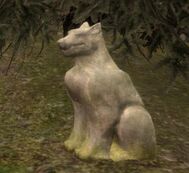WardenWade (talk | contribs) No edit summary Tag: Visual edit |
(→Falon'Din: Friend of the Dead, the Guide:
Inserted a little snippet of lore from Solas' comments on the mosaic of Falon'Din at the Temple of Mythal.) Tag: Visual edit |
||
| Line 5: | Line 5: | ||
Interestingly, though the elven gods are responsible for the gifts of the world, and in some cases for recreating it, they too were created by and are ''not'' creators of the world according to elven belief.<ref>{{BSN|author=[[David Gaider]]|date=2009|url=http://social.bioware.com/forum/1/topic/47/index/508455/3|title=The Chantry, The Maker, The Old Gods: questions}}</ref> Their current location is uncertain, as they are not apparently able to interact with the mortal world. However, elven belief holds that the [[Fade]], or Beyond as it is known to the elves, is considered a holy place and the gods are trapped there in the "Eternal City."<ref name="wot143">{{Cite wot|143}}</ref> |
Interestingly, though the elven gods are responsible for the gifts of the world, and in some cases for recreating it, they too were created by and are ''not'' creators of the world according to elven belief.<ref>{{BSN|author=[[David Gaider]]|date=2009|url=http://social.bioware.com/forum/1/topic/47/index/508455/3|title=The Chantry, The Maker, The Old Gods: questions}}</ref> Their current location is uncertain, as they are not apparently able to interact with the mortal world. However, elven belief holds that the [[Fade]], or Beyond as it is known to the elves, is considered a holy place and the gods are trapped there in the "Eternal City."<ref name="wot143">{{Cite wot|143}}</ref> |
||
| − | In elven history, orbs called "foci" were sometimes used to channel the power of the elven gods for various reasons. These items were usually associated with a particular member of the elven pantheon, and their power required a great deal of energy to unlock.<ref>According to [[Solas]].</ref> |
+ | In elven history, orbs called "foci" were sometimes used to channel the power of the elven gods for various reasons. These items were usually associated with a particular member of the elven pantheon, and their power required a great deal of energy to unlock.<ref name=":0">According to [[Solas]].</ref> |
== History == |
== History == |
||
| Line 54: | Line 54: | ||
Falon'Din is also known as a "twin soul" to Dirthamen: a non-romantic, quintessentially elven relationship that binds beyond friendship. In some corners the two gods are not referred to as brothers at all.<ref>According to mosaic tile entries in the [[Temple of Mythal]].</ref> |
Falon'Din is also known as a "twin soul" to Dirthamen: a non-romantic, quintessentially elven relationship that binds beyond friendship. In some corners the two gods are not referred to as brothers at all.<ref>According to mosaic tile entries in the [[Temple of Mythal]].</ref> |
||
| + | |||
| + | It is also said that Falon'Din's vanity and desire for worshippers was so great he started brutal wars to gain more, killing all who would not bow to him. Only once Mythal rallied the other gods and they attacked Falon'Din in his own temple did he surrender. <ref name=":0" /> |
||
=== Dirthamen: Keeper of Secrets === |
=== Dirthamen: Keeper of Secrets === |
||
Revision as of 13:34, 21 December 2014
The elven pantheon comprises five gods and four goddesses, whom the modern Dalish elves refer to as "the Creators." The pantheon is led by Elgar'nan the All-Father, god of fatherhood and vengeance, and Mythal the Protector, goddess of motherhood and justice. There are also references in elven mythology to another race of gods, called "The Forgotten Ones," the enemies of the elven pantheon. It is said that Fen'Harel was the only one able to walk freely between the two clans, and they both thought of him as one of their own.
Interestingly, though the elven gods are responsible for the gifts of the world, and in some cases for recreating it, they too were created by and are not creators of the world according to elven belief.[1] Their current location is uncertain, as they are not apparently able to interact with the mortal world. However, elven belief holds that the Fade, or Beyond as it is known to the elves, is considered a holy place and the gods are trapped there in the "Eternal City."[2]
In elven history, orbs called "foci" were sometimes used to channel the power of the elven gods for various reasons. These items were usually associated with a particular member of the elven pantheon, and their power required a great deal of energy to unlock.[3]
History
- See also: Elves#History
The presence of figures depicting the elven gods lingers in the wild places of Thedas.[4]
The elven pantheon was revered in the time of Elvhenan, before the humans came to Thedas. Little is known about how the gods were worshipped at this time except that the gods had temples with guards in specially made armor,[5] the elves worshiped their gods for months at a time,[6] and that worship may have included rituals involving water and kneeling and praying before altars.[7]
Once the elves found that the very presence of the humans, or "quicklings," caused the once immortal elves to age and die, they attempted to isolate themselves. Many believed that the gods had judged them unworthy of their long lives and cast them down among the quicklings.[8] The elves retreated within Elvhenan but were ultimately conquered and enslaved by the Tevinter Imperium. During their centuries of slavery, the elves lost most of their language and history and the worship of the old elven pantheon declined. However, the elves, led by Shartan, stood beside Andraste in her fight against the Imperium, and their reward was a new home in The Dales, where the worship of the elven pantheon could be revived. The elves left Tevinter for their new homeland in -170 Ancient (1025 TE).
The elves' new homeland was to be short-lived by the standards of Elvhenan, however. Over the next 270 years or so, relations between the elves and their human neighbours deteriorated, and in the early Glory Age there were numerous border skirmishes between The Dales and Orlais which soon escalated into war. When it appeared that the elves might actually capture Val Royeaux, the Chantry called for a holy war, resulting in a new Exalted March against The Dales that completely crushed the elves by 2:20 Glory. The lands of the Dales were appropriated by Orlais, with elven settlements being uprooted and worship of the elven gods forbidden. Elves who accepted the Chantry's offered truce were required to accept the Maker and live in ghettos, known as Alienages within human settlements. Some elves, however, refused to give up their worship or their dream of their own homeland, and they became the Dalish.
Pantheon
Elgar'nan: God of Vengeance
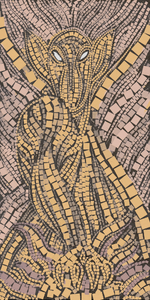
Elgar'nan: God of Vengeance
(ell-GAR-nan)
Long ago, when time itself was young, the only things in existence were the sun and the land. The sun, curious about the land, bowed his head close to her body, and Elgar'nan was born in the place where they touched. As a gift to Elgar'nan, the land brought forth great birds and beasts of sky and forest, and all manner of wonderful green things.
—From Codex entry: Elgar'nan: God of VengeanceElgar'nan--also known as the All-Father, the Eldest of the Sun and He Who Overthrew His Father[9]--represents fatherhood and vengeance, and leads the pantheon with the goddess Mythal. He was the first of the elven gods, born of the sun and the earth. According to elven legend, the sun grew jealous of the favor shown by Elgar'nan for the things of the earth, and so burned them to ashes. In retaliation, Elgar'nan threw the sun down from the sky, and only later relented because of Mythal's intervention. He was convinced, with her help, to restore his father to the sky on the promise that the sun would set each night.[9] With the aid of Mythal and his parents, Elgar'nan remade the world. Most elves will invoke Elgar'nan's name when they need to destroy something.
Mythal: the Great Protector
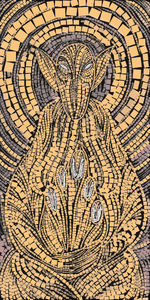
Mythal: the Great Protector
(mith-al)
It was at this moment that Mythal walked out of the sea of the Earth's tears and onto the land. She placed her hand on Elgar'nan's brow, and at her touch he grew calm and knew that his anger had led him astray.
—From Codex entry: Mythal: the Great ProtectorMythal, the Protector and the All-Mother, and goddess of love[10], is the patron of motherhood and justice and leads the pantheon with her male counterpart, Elgar'nan. In elven legend, when Elgar'nan threw the sun out of the sky in vengeance for burning the earth to ashes, Mythal calmed him and helped him see that he was wrong. Elgar'nan was convinced to free the sun. On the first night after the sun was released Mythal created the moon, from the glowing earth round its bed, to be placed in the sky as a pale reflection of the sun's true glory.[9] Elves will invoke Mythal's name when they require protection. In the past, they also petitioned her on matters of justice and it is said that those who came to her with clear minds and open hearts were granted judgment and protection; Mythal harried their enemies until the end of their days. While those who tried to manipulate her wrath against those they envied or were being petty over imagined slights were swiftly struck down.[11]
Falon'Din: Friend of the Dead, the Guide

Falon'Din: Friend of the Dead
(fahl-awn-DEEN)
In ancient times, the People were ageless and eternal, and instead of dying would enter uthenera-the long sleep-and walk the shifting paths beyond the Veil with Falon'Din and his brother Dirthamen. Those elders would learn the secrets of dreams, and some returned to the People with newfound knowledge.
—From Codex entry: Falon'Din: Friend of the Dead, the Guide- O Falon'Din
- Lethanvir--Friend to the Dead
- Guide my feet, calm my soul,
- Lead me to my rest."
- --from Elven Prayer for the Dead
Falon'Din is the elven God of Death and Fortune and guides the dead to the Beyond. He and his twin brother, Dirthamen, are the eldest children of Elgar'nan the All-Father and Mythal the Protector and were inseparable from birth. Their first separation came when Falon'Din found an old and sickly deer in the forest and gathered her up into his arms and carried her to her rest beyond the Veil, where Dirthamen could not follow.
Since then he has guided elders on journeys of enlightenment while in Uthenera,[12] and later swore to guide all creatures beyond the Veil when they died. Falon'din's husbandry of the dead has taken on additional meaning since elves have become mortal.[13]
Falon'Din is also known as a "twin soul" to Dirthamen: a non-romantic, quintessentially elven relationship that binds beyond friendship. In some corners the two gods are not referred to as brothers at all.[14]
It is also said that Falon'Din's vanity and desire for worshippers was so great he started brutal wars to gain more, killing all who would not bow to him. Only once Mythal rallied the other gods and they attacked Falon'Din in his own temple did he surrender. [3]
Dirthamen: Keeper of Secrets
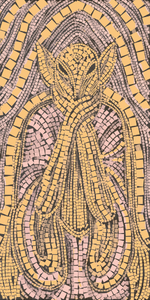
Dirthamen: Keeper of Secrets
Dirthamen wandered aimlessly till he came across two ravens. "You are lost, and soon you will fade," the raven named Fear said to Dirthamen. "Your brother has abandoned you. He no longer loves you," said the other, named Deceit. "I am not lost, and Falon'Din has not abandoned me," replied Dirthamen. He subdued the ravens and bade them carry him to Falon'Din.
—From Codex entry: Dirthamen: Keeper of SecretsDirthamen is the twin brother of Falon'Din. He is the elven god of secrets and knowledge, and master of the ravens Fear and Deceit, having outsmarted them both.[13] Dirthamen gave to elves the gift of knowledge and taught them loyalty and faith in family.[4]
There are several elven legends involving the Keeper of Secrets. In the days before Arlathan, the first varterral was formed from the fallen trees of the forest to guard an ancient city said to be beloved by Dirthamen.[15] Another tale says that he gave each creature a secret to keep. However, the hares shouted their secret to the treetops, the birds sold theirs for gold and the foxes traded their secret for wings. Only the bears kept Dirthamen's secret, so the bear is considered beloved of Dirthamen.[16]
Dirthamen is also known as a "twin soul" to Falon'Din, rather than merely a twin.[17]
Andruil: Goddess of the Hunt

Andruil: Goddess of the Hunt
(AWN-droo-eel)
I am Sister of the Moon, Mother of Hares,
Lady of the Hunt: Andruil.
Remember the Ways of the Hunter
And I shall be with you.
Andruil is the elven Goddess of the Hunt, creator of the Vir Tanadahl or Way of Three Trees. First, the Vir Assan, or Way of the Arrow: fly straight and do not waver. Second, the Vir Bor'assan, or Way of the Bow: bend but never break. Third, the Vir Adahlen, or Way of the Forest: together we are stronger than the one. The hawk and the hare in particular are beloved of Andruil.[18] Andruil watched over the animals of the forest and taught elves to respect them.[4]
In the Temple of Mythal, Solas reveals that, contrary to Dalish depictions, Andruil was actually known as the Goddess of Sacrifice, who had hunted elves as well as animals.[19]
Sylaise: the Hearthkeeper
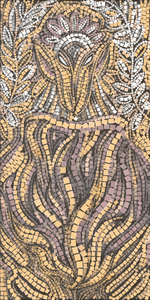
Sylaise: the Hearthkeeper
(SEE-layse)[20]
It is Sylaise who gave us fire and taught us how to use it. It is Sylaise who showed us how to heal with herbs and with magic, and how to ease the passage of infants into this world. And again, it is Sylaise who showed us how to spin the fibers of plants into thread and rope.
—From Codex entry: Sylaise: the HearthkeeperSylaise, the Hearthkeeper, is seen as the sister of Andruil the Huntress. Sylaise gave the elves fire, taught them how to weave rope and thread, and to use herbs and magic for healing purposes. In her youth, Sylaise stayed at the home-tree to sing and create art while Andruil hunted and played.[4] Her path is called the Vir Atish'an.
June: God of the Craft
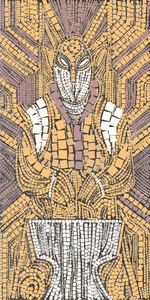
June: God of the Craft
(Joo-NAY)
We dedicate all our crafts to June, for it is he who taught the People to bend the branches of trees to make our bows, and to fashion coverings of furs and ironbark. Without June, would we have the aravel, or the harnesses for our halla?
—From Codex entry: June: God of the CraftJune is the elven Master of Crafts, and brother to Andruil and Sylaise. He taught the elves to make all needful things,[13] and in particular used Sylaise's gentle lessons to the elven people to teach them how to make bows, arrows, and knives to hunt Andruil's gifts.[4] Elven legend tells how, before Sylaise came to teach them the use of fire and June to teach them to fashion bows and knives, the elves wandered the forests without purpose, eating only the berries and nuts they could find and shivering naked through cold nights. It is said that he created himself.[13]
Ghilan'nain: Mother of the Halla
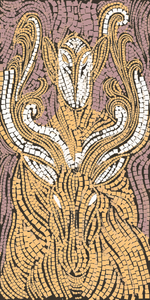
Ghilan'nain: Mother of the Halla
One day, Ghilan'nain came across a hunter she did not know. At his feet lay a hawk, shot through the heart by an arrow. Ghilan'nain was filled with rage, for the hawk is an animal much beloved of Andruil. Ghilan'nain called upon the goddess to curse him, so that he could never again hunt and kill a living creature. Ghilan'nain's curse took hold, and the hunter found that he was unable to hunt. Ashamed, the hunter swore he would find Ghilan'nain and repay her for what she had done to him. He blinded her first, and then bound her as one would bind a kill fresh from the hunt. But because he was cursed, the hunter could not kill her. Instead he left her for dead in the forest. And Ghilan'nain prayed to the gods for help. Andruil sent her hares to Ghilan'nain and they chewed through the ropes that bound her, but Ghilan'nain was still wounded and blind, and could not find her way home. So Andruil turned her into a beautiful white deer—the first halla.
—From Codex entry: Ghilan'nain: Mother of the HallaGhilan'nain is called the Mother of the Halla--white deer-like creatures revered by the Dalish and used to pull their aravel, or "landships"--and goddess of navigation. According to Dalish tales, Ghilan'nain was once a mortal woman and beloved of Andruil. She was betrayed by an elven hunter and left for dead, only to be transformed into a Halla and offered apotheosis for her devotion to animals. Ghilan'nain is invoked when the Dalish wish to travel quickly.[13]
According to an inscription in the Temple of Mythal, however, in addition to the halla, Ghilan'nain had created many other creatures -- giants, monsters, and beasts that spanned across the sky, water, and earth. These creatures Ghilan'nain killed after Andruil approached her with an offer for apotheosis -- all except a few, with the halla being one of them. She thus became known as the youngest elven god. [21]
Fen'Harel: The Dread Wolf

Fen'Harel: The Dread Wolf
- See also: Fen'Harel
In ancient times, only Fen'Harel could walk without fear among both our gods and the Forgotten Ones, for although he is kin to the gods of the People, the Forgotten Ones knew of his cunning ways and saw him as one of their own. And that is how Fen'Harel tricked them. Our gods saw him as a brother, and they trusted him when he said that they must keep to the heavens while he arranged a truce. And the Forgotten Ones trusted him also when he said he would arrange for the defeat of our gods, if only the Forgotten Ones would return to the abyss for a time. They trusted Fen'Harel, and they were all of them betrayed. And FenHarel sealed them away so they could never again walk among the People.
—From Codex entry: Fen'Harel: The Dread Wolf
The Dread Wolf is an enigmatic trickster god of the elves, whose supposed betrayal of both the benevolent Creators and malefic Forgotten Ones is the only explanation most elves have to explain the destruction of Arlathan. Dalish clans view him with wariness and seek to protect themselves and their kin from his treachery.
It is revealed by Solas in Mythal's temple that this could be a misinterpretation by the Dalish and instead he was the god of rebellion.[22]
The Forgotten Ones
- See also: The Forgotten Ones
Only in dreams do we hear whispered the names of Geldauran and Daern'thal and Anaris, for they are the Forgotten Ones, the gods of terror and malice, spite and pestilence.
There are references in elven mythology to another race of gods: gods of evil, with whom the gods of the elven pantheon fought an endless war. These gods are now known as the Forgotten Ones, and for good reason as even the hahrens, or elven elders, know little to nothing about them. According to legend they, along with the elven pantheon, were trapped away from the world at around the time of the fall of Arlathan.
Vallaslin: Blood writing
- Main article: Blood writing
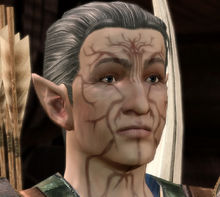
Vallaslin, or blood writing, on the face of Athras, a Dalish hunter.
I asked him about the intricate tattoos on his face; he told me they were called vallaslin--"blood writing." His were symbols of Andruil the Huntress, one of the most highly revered elven goddesses.
When a Dalish elf comes of age, they are marked with intricate tattoos representing one of the elven gods. The tattooing is preceded by meditation on the gods and the ways of the Dalish, and by purifying the body and the skin. It is not known whether this practice was part of the worship of elven gods in ancient Elvhenan or is a more recent development.
Trivia
- It is interesting to note that both elves and humans have legends of imprisoned gods.[23] However, there is no known link between the stories of the Old Gods and those of either the elven pantheon or the Forgotten Ones.
Gallery
References
| ||||||||||||||||||





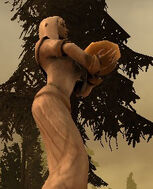
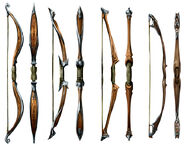
![Dalish weapons.jpg (406 KB) A selection of Dalish weaponry[24]](https://static.wikia.nocookie.net/dragonage/images/b/b9/Dalish_weapons.jpg/revision/latest/scale-to-width-down/151?cb=20190706113229)

